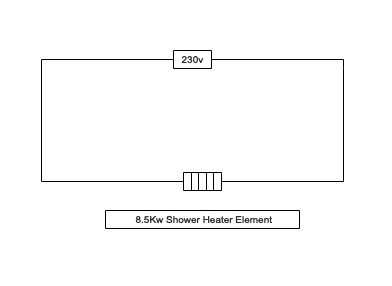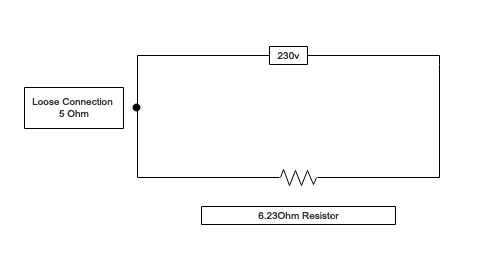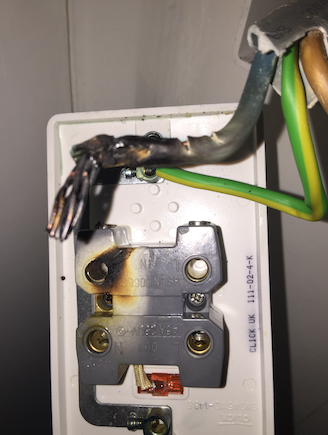Loose Connections
09/06/19 17:23
Occasionally I see loose connections within accessories and the effects of those. So in this entry I wanted to explain what happens in a circuit where a loose connection is present.
You’ll hear lots of people tell you that a loose connection causes more current draw and as a result produces heat. This isn’t actually true and I’ll explain why.
Imagine a shower circuit like the one below (This is a very simplified illustration):

Here we have a typical electrical shower of 8.5Kw running from a 230v power source as in a domestic dwelling.
We can evaluate that the resistance of the shower element is:
R = V^2/P
R = 230^2/8500
R = 6.23Ohms
We can also establish the current flow through it as:
I = V/R
I = 230/6.23
I = 36.91Amps
Or
I = P/V
I = 8500/230
Again I = 39.91 Amps
So, we can redraw the circuit as:

Now, if we add a loose connection, say at the shower isolator:

We can calculate the total resistance in the circuit to be 6.23 + 5 = 11.23 Ohms
Using that to calculate the new total current flow in the circuit we see:
I = V/R
I = 230/11.23
I = 20.48 Amps
Compare this with the original current flow of 36.91 Amps and we can see that there is actually less current draw in the faulty circuit than in the healthy one.
The problem arises though when we consider the power dissipated by the shower element alone:
P = I^2R
P = 20.48^2 x 6.23
P = 2613W
This means that in order for the heater element to bring the water up to temperature it has to work for longer.
Now, if we look at the power being dissipated by the 5 Ohm fault resistance we see:
P = I^2R
P = 20.48^2 x 5
P = 2097W
So, we can see that a huge amount of power is being dissipated at the fault. This is the result.

So, we do get a huge amount of power and heat at the fault which is a common cause of fire, but the current flow is not actually in the circuit as a result of the fault.
You’ll hear lots of people tell you that a loose connection causes more current draw and as a result produces heat. This isn’t actually true and I’ll explain why.
Imagine a shower circuit like the one below (This is a very simplified illustration):

Here we have a typical electrical shower of 8.5Kw running from a 230v power source as in a domestic dwelling.
We can evaluate that the resistance of the shower element is:
R = V^2/P
R = 230^2/8500
R = 6.23Ohms
We can also establish the current flow through it as:
I = V/R
I = 230/6.23
I = 36.91Amps
Or
I = P/V
I = 8500/230
Again I = 39.91 Amps
So, we can redraw the circuit as:

Now, if we add a loose connection, say at the shower isolator:

We can calculate the total resistance in the circuit to be 6.23 + 5 = 11.23 Ohms
Using that to calculate the new total current flow in the circuit we see:
I = V/R
I = 230/11.23
I = 20.48 Amps
Compare this with the original current flow of 36.91 Amps and we can see that there is actually less current draw in the faulty circuit than in the healthy one.
The problem arises though when we consider the power dissipated by the shower element alone:
P = I^2R
P = 20.48^2 x 6.23
P = 2613W
This means that in order for the heater element to bring the water up to temperature it has to work for longer.
Now, if we look at the power being dissipated by the 5 Ohm fault resistance we see:
P = I^2R
P = 20.48^2 x 5
P = 2097W
So, we can see that a huge amount of power is being dissipated at the fault. This is the result.

So, we do get a huge amount of power and heat at the fault which is a common cause of fire, but the current flow is not actually in the circuit as a result of the fault.








